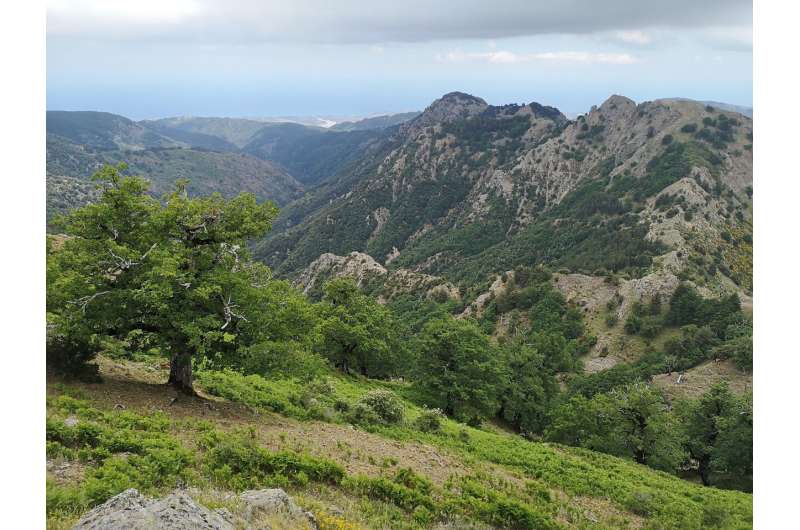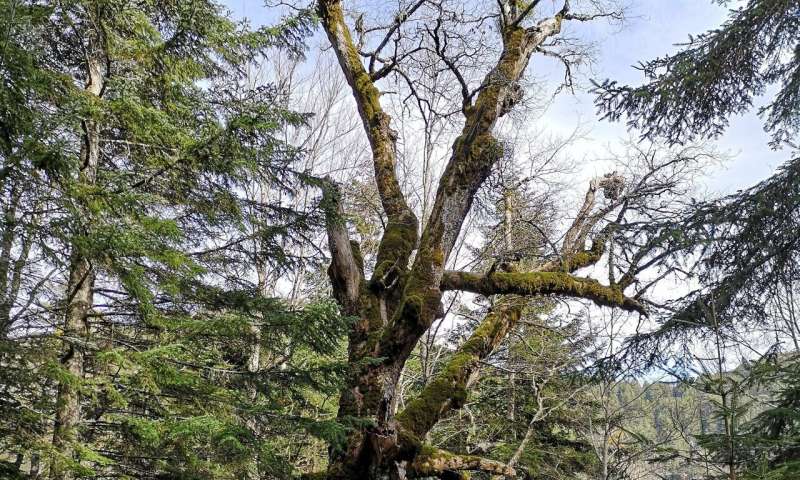Oldest radiocarbon dated temperate hardwood tree in the world discovered in southern Italy

Radiocarbon dating of five large and potentially old sessile oaks from Aspromonte National Parks has revealed a long lifespan ranging from 934 ± 65 to 570 ± 45 years. For a long time, majestic oaks have been considered a symbol of longevity, and this study proves that a millennium age horizon is attainable longevity in angiosperms growing at high-elevation belt in Mediterranean mountains of South Italy.
Dating large old trees: a challenging task
"Studying the longevity of trees in response to climate change under different environments is a research priority for both nature conservation and climate change mitigation strategies," says Gianluca Piovesan from University of Tuscia, Dafne. "For a long time, majestic oaks have been considered a symbol of longevity. In a study just published in the journal Ecology, we dated five large and potentially old sessile oaks from Aspromonte National Parks using radiocarbon, revealing unexpected long lifespan ranging from 934 ± 65 to 570 ± 45 years.
Jordan Palli and Michele Baliva from Dendrology Lab, University of Tuscia, say: "The sampling was arduous for two reasons: Firstly, these ancient trees stand on steep, rocky slopes that are difficult to reach and to walk through. Secondly, very old individuals are often rotten or hollowed in the inner part of the stem, given the centuries of exposure to the elements and to natural pests and pathogens. This means that the oldest rings were often missing or severely degraded, challenging the identification and collection of the closest tree rings to the pith for radiocarbon dating. In the Dendrology Lab we carried out a careful stereoscope screening to identify the oldest rings in our samples. Given the very narrow size of the rings, we had to use a scalpel to collect them."
Demeter: the oldest dated hardwood tree in the temperate and boreal regions

The discovery of Demetra and of the other old oaks closes the trilogy of the oldest dated conifers (eg, one Pinus Heldreichii, nicknamed Italus) and hardwoods (Michele and Norman) in Europe. The articles have been published in the journal Ecology. All these trees grow in the mountains of southern Italy between the Pollino and Aspromonte National Parks.
Preservation of old-growth forests and natural landscapes and public outreach as a tool for a sustainable future
"The discovery of these long-lived sessile oaks in the high-elevation mountain environment of Aspromonte confirms the high level of naturalness of forest ecosystems in protected areas of the southern Apennines," says Antonino Siclari from the Aspromonte National Park.
Aspromonte, Sila and Pollino National Parks are located in the southern part of the European Mediterranean region, a biodiversity hotspot for forest conservation. Here, the strict nature reserves preserve the old-growth forests and associated threatened species that require very old habitat trees of conifers and angiosperms (e.g., Buprestis splendens or Osmoderma italicum, respectively).

Demetra was painted by Mery Rigo. Artists can play a cultural transformation role in society by helping to raise awareness on nature protection and to engage people in conservation messaging. Preserving biodiversity is a requirement for sustainable development, and the long-life cycle of Aspromonte oaks is a reminder of the need to leave adequate space for natural processes to take place. "As Michelangelo Pistoletto affirmed," says Mery Rigo, "nowadays art can and must have an active role in promoting an utterly new and correct relationship between mankind and nature. Portraying Demetra—with a particular technique based on painting, photography and digital processing was a great emotion for me, and with my intervention, I hope to have made a little contribution to the cause."
Radiocarbon dating of old trees for the advancement of biological and environmental sciences
Radiocarbon dating analyses were carried out at the accelerator mass spectrometry facility at the University of Salento in Lecce, Italy. "The use of the radiocarbon dating method allowed us to assess the absolute age of the trees with a high degree of accuracy while advanced statistical tools for data analysis helped us to improve the achieved chronological resolution," says Gianluca Quarta, professor of Applied Physics at CEDAD.
Aspromonte is located in the middle of the Mediterranean basin a key area for climatic reconstructions. "An additional ecological value of old forest such as the one in Aspromonte is that they can be used to trace back the environmental history of the area. The information contained in tree rings can be decoded and use to interpret how environmental influences, particularly climate, shaped forest structure and function and this is the next step we are taking with Aspromonte oaks," says Isabel Dorado-Liñán.
"These long-lived trees are witnesses of our past. The history of our climate, of solar activity, of the human impact on the environment is registered in their rings and we are sure that other important discoveries are going to come," concludes Lucio Calcagnile, director of CEDAD.
More information: Gianluca Piovesan et al. Radiocarbon dating of Aspromonte sessile oaks reveals the oldest dated temperate flowering tree in the world, Ecology (2020). DOI: 10.1002/ecy.3179
Journal information: Ecology
Provided by University of Tuscia





















